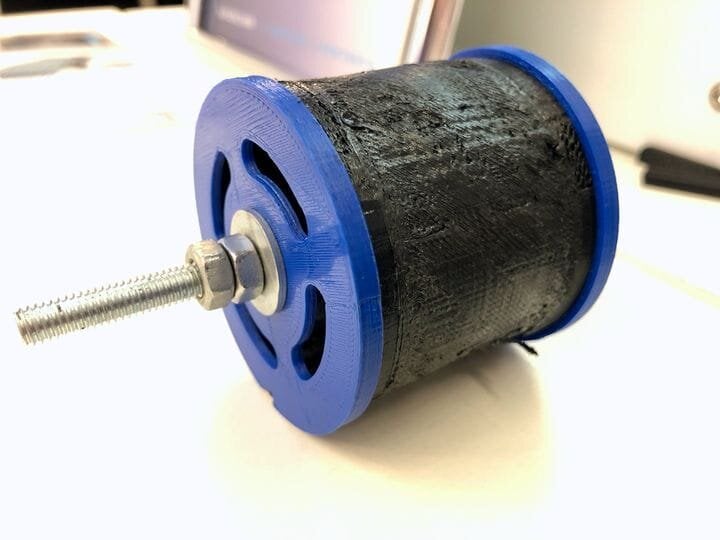![The Stereotech STE520 “5D” printer [Source: Fabbaloo]](https://fabbaloo.com/wp-content/uploads/2020/05/image-asset_img_5eb08c6c5c3e0.jpg)
I’ve seen one of the most unusual 3D printers: a five axis filament 3D printer from Stereotech.
Most filament (FFF) 3D printers use a cartesian system in which the motion system moves in three axes: left, right and vertical. A smaller number of devices use a delta motion system, and a very few use a polar approach.
5D 3D Printing
But the 5D STE520 3D printer from Volgograd-based Stereotech is something quite different.
![Five-axis motion system on the Stereotech STE520 “5D” printer [Source: Fabbaloo]](https://fabbaloo.com/wp-content/uploads/2020/05/image-asset_img_5eb08c6c872c9.jpg)
As you can see in this image, there is no print bed at all. Instead printing takes place on a rotational axis that you can see in the center of the image. There are five axes: the printhead moves in the X and Y axes; the platform moves up and down as the Z axis; the new component in the center both tilts and rotates.
![Unusual 3D print made with no supports by the Stereotech STE520 “5D” printer [Source: Fabbaloo]](https://fabbaloo.com/wp-content/uploads/2020/05/image-asset_img_5eb08c6cad47c.jpg)
This allows the STE520 to 3D print extrusions in virtually any orientation. For example, a cylinder could be 3D printed with extrusions around the width of the cylinder, but then a handle could be 3D printed on the side of the cylinder with extrusions following the curve of the handle.
5D Printing Advantages
This capability has several important implications.
One is that there is no need for support structures. When an “overhang” is encountered, the print is simply rotated so that it is no longer an overhang and printing proceeds. That should dramatically speed up post processing, as no supports need to be removed. Stereotech says they can 3D print “any geometry without support”.
![Nice 3D print by the Stereotech STE520 “5D” printer. Note different alignment of layer lines [Source: Fabbaloo]](https://fabbaloo.com/wp-content/uploads/2020/05/image-asset_img_5eb08c6ccf0c2.jpg)
The second implication is that 3D prints can be made far stronger by ensuring the extrusions align with the expected stresses of the part’s usage. Stereotech says the prints can be up to 4X as strong as conventional prints, but this depends on the geometry and usage of the part.
While some conventional 3D printers can extrude continuously in “vase” or “spiral” modes, the possibilities for continuous 3D printing are a lot more grand with the STE520.
STE520 Materials
Stereotech says they are able to 3D print several different materials with the system, including polycarbonate, nylon and some carbon fiber composite materials. Although the current device does not have the capability of 3D printing high temperature materials such as PEEK or ULTEM, they are apparently partnering with an unnamed high temperature company to develop a high temperature version of the STE520.
5D Print Bed
One confusing aspect for me was the manner of starting a 3D print. Usually you have a print bed, powder surface or metal plate upon which printing takes place. However, there is no such animal in the Stereotech 5D configuration. I wondered if you simply 3D print on a cylindrical rod, and then have a “hole” in every 3D print.
Apparently this is not the case. One way to 3D print is to first 3D print a “rod” out of the same material on a conventional 3D printer. Then this 3D printed rod is placed in the chuck on the STE520 and it is the base for 5D printing. Since it’s the same material, it becomes part of the final object and you need only chop off a bit of the rod that’s sticking out of the finished print.
![Unusual custom 3D print “bed” mount for the Stereotech STE520 “5D” printer [Source: Fabbaloo]](https://fabbaloo.com/wp-content/uploads/2020/05/image-asset_img_5eb08c6d00c63.jpg)
However, there are more complexities here. You don’t necessarily have to 3D print a simple rod as a printing base. Instead you could produce or use any kind of object that can fit in the STE520’s chuck. You could print on top of an object, for example. The possibilities here are endless.
5D Printing Operations
And that led me to the question of usage. This machine is quite a bit different from using a conventional 3D printer as there are so many different ways to do so. Stereotech admits it will take a bit of time to understand the machine and its operations.
Towards that end, the company has partnered with Moscow-based AM software company ATSS to create new slicing software for 5D printing.
I think this is the right approach, but such software would have to be very carefully designed to make the operator experience as simple as possible, otherwise buyers may be spooked by the complexity and revert to more conventional options.
Stereotech STE520 Availability
The STE520 is not yet available, but Stereotech tells us they intend on selling the device to the pubic some time in 2021.
Via Stereotech

